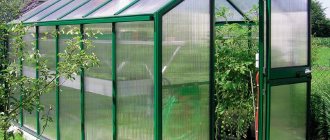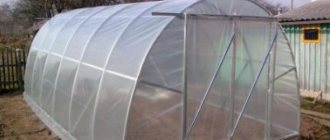If the approach to energy conservation is “scientific”, then you will need devices of a more complex design.
Electricity (lighting, heating) has a beneficial effect on the future harvest, and small greenhouses are usually built to reduce energy costs. They must constantly monitor the difference between the air temperature in the greenhouse and outside it. Try to reduce it to the required levels.
Especially for this, devices were created that monitor the level of wind, moisture, and, of course, thermostats that are responsible for a constant temperature. Only by taking into account and controlling all parameters important for the crops being grown can their high yields be guaranteed. An automatic thermostat for greenhouses will help you achieve this.
Today this is not a luxury available only to the rich or large companies, but a necessary measure for every farmer. The devices perform best in partly cloudy conditions. Controlling the change of parameters in the greenhouse “with your own hands” is not an easy task.
To sum it up, we can say that modern inventions make human work easier. Thus, thermostats constantly maintain the same temperature, which is so necessary for your plants. The most important indicator of such devices is that they work even if a person is far from them.
Content
Control of these systems and subsequent adjustments are made using an air temperature regulator, which is the most important part for obtaining a full-fledged harvest, since even minimal changes in data can negatively affect the development of plantings, not excluding their death.
Monitoring plant development using an industrial thermostat
Scrupulous adherence to temperature conditions is a guarantee of decent harvests
Individual adjustment of the thermostat allows you to control the temperature level throughout the day, stabilizing the boiler’s protective function against overheating.
For most plantings, the most comfortable temperature is 16 - 25 °C; any even minor deviations inhibit the development of plants and can lead to the development of diseases and withering of plantings. Control is necessary not only for the air temperature of the greenhouse, but also for the temperature of the soil. These two indicators are dominant when creating conditions for plant development. The correct absorption of nutrients found in the soil depends on them, and they directly affect the growth and full development of plants.
For soil, you should adhere to the temperature range of 13 - 25 °C; its exact indicators are determined depending on the type of crop.
Please note! Changes in soil temperature are often more detrimental to plantings than a decrease in air temperature.
Soil temperature for seedlings
It should be remembered that in a greenhouse, the temperature of not only the air, but also the soil is important. It determines how actively plants will absorb nutrients from the soil.
- So, if the temperature of the earth drops below +10°C, this has a rather bad effect on the condition of the plants.
- First of all, at this temperature, plant roots cannot absorb phosphates from the ground, as a result of which the plant becomes lethargic and grows much more slowly.
- Some gardeners are faced with a situation where applying fertilizers does not produce any results.
At the same time, they mainly “sin” precisely on the quality of fertilizers. But the problem may actually lie in excessively low soil temperatures.
Basics of the functioning of temperature control devices ↑
The operating principle of structures of this type is simple: the control device receives a signal, after which different installation models can react in a similar way:
- increase or decrease the power of the heating system;
- open or close the natural ventilation flaps;
- connect or completely disconnect the heating of irrigation water and soil in the beds.
turn on or off the room ventilation;
The appearance of signal pulses is carried out using a thermostat relay, which, in turn, receives data from sensors located in the greenhouse. The most commonly used sensors are the following devices:
- A thermistor is often used as a temperature sensor. In home-made installations, a pn junction of a semiconductor transistor or diode is often used as a temperature-sensitive element.
- A photoresistor is used as a light sensor, and in homemade designs, the pn junction of a semiconductor transistor or diode, whose reverse resistance directly depends on the illumination, can be used. To gain light access to the system, the cap from the metal case is cut off from the transistor, and the paint from the glass is removed from the diode.
Greenhouse humidity and temperature controller - Arduino
Greenhouse humidity and temperature controller - Arduino
- Humidity parameters are regulated by industrial sensors, the indicators of which depend on the moisture permeability of the medium located between the condenser plates. Changes in resistance when aluminum oxide interacts with humidified air can also be taken into account. When adjusting air humidity, the result of changing the length of synthetic fiber or human hair, etc. is also taken into account. For home-made devices, a similar sensor is a piece of foil fiberglass with cut grooves.
For your information! For small greenhouses for personal use, from an economic point of view, it is absolutely unprofitable to purchase an expensive industrial system. In such situations, self-made thermostats for greenhouses are successfully introduced.
Principles of constructing a thermostat for a greenhouse with your own hands ↑
Building a temperature controller yourself is a very real task. But this will require basic engineering knowledge and technical skills.
The main functioning of the system is carried out by introducing into the design an 8-bit microcontroller of the PIC16F84A brand.
As a temperature sensor, a digital thermometer of the integral variety DS18B20 is built in, which has operating functionality in the range t -55 - +125°C. It is also possible to use a digital temperature sensor TCN75-5.0, which in terms of parameters, compact size and relative lightness of design is quite suitable for use in various automatic devices.
Digital temperature sensor
Such digital sensors essentially have minor errors in measurements, so the parallel use of several types of sensors makes it possible to observe the heating temperature virtually without errors.
The ability to control the degree of load is carried out using a small-sized relay K1, which corresponds to an operating voltage of 12 V. The load is connected to the relay through the contacts and this allows it to switch it. Indication is made using any four-digit LEDs.
The degree of temperature response is set: SB1-SB2 (microswitches). The microcontroller memory is energetically self-contained and stores the specified parameters. Using the operating mode on the liquid crystal display panel of the device, you can see the current indicators of the measured temperature.
On a note! Such electronic thermostats are becoming increasingly popular because they have the ability to sense the temperature at any point inside the greenhouse, and the monitoring sensor can be placed between the plants, in the soil substrate, or suspended near the roof. Such a wide range of placement allows the thermostat to have accurate data on the state of the internal environment of the greenhouse.
How to make a thermostat for a greenhouse with your own hands ↑
Craftsmen make simplified thermostats for personal greenhouses with their own hands. Before choosing a greenhouse automation scheme, you must first establish the data of the control objects.
The photo shows a circuit of a thermostat with two transistors of type VT1 and VT2. The RES-10 relay is used as an output device. Temperature sensor - thermistor MMT-4.
One of the models of a home-made thermostat could be, for example, this design. In it, a dial thermometer that has been modified can be used as a temperature sensor:
- The thermometer design is completely disassembled.
- In the adjustment scale, a 2.5 mm hole is drilled.
- On the contrary, the phototransistor is installed in a specially designed corner made of thin tin or sheet aluminum, in which holes 0 2.8 mm are pre-drilled. Glue is applied to the phototransistor along the edge and placed in the socket.
- The corner with the phototransistor is attached to the scale using Moment glue.
- A stop is attached below the hole.
- A small 9 volt light bulb is installed on the other side of the thermometer. • A lens is placed between the scale and the light bulb - for a clear response of the device to the indicators.
- Thin phototransistor wires are laid through the central hole of the scale.
- A hole is drilled in the plastic case for the light bulb wires. The tourniquet is threaded into a vinyl chloride tube and secured with a clamp.
Scheme for self-assembly of a thermostat
In addition to the sensor, the thermostat must include a photo relay and a voltage stabilizer.
The stabilizer is assembled according to the usual scheme. A photo relay is also not difficult to make. The photocell is the GT109 transistor.
A mechanism based on a converted factory relay is best. The work is carried out on the principle of an electromagnet, where the armature is drawn into a coil. The switch (2A, 220V) controls the electromagnetic starter to supply power to the heating devices.
Photo relays and power supplies are located in a common housing. A thermometer is attached to it. A toggle switch and a light are attached to the front side, notifying that the heating elements are turned on.
Ventilation diagram ↑
If the greenhouse is ventilated using an electric fan, two-position thermostats can be used. To create the desired fan operating mode, connect an intermediate relay.
If the greenhouse has built-in windows, you need to provide them with an electric drive (electromagnets or electric motor mechanisms).
But it is easier to solve the issue of greenhouse ventilation when using direct-acting thermostats. In them, the actuator and thermostat are located in one device. However, for regulators of this type, the temperature range can be up to 5 °C. To achieve more precise adjustment, it is better to choose electronic regulators.
Ventilation of a greenhouse according to G. Ivanov’s method
Ventilation of a greenhouse according to G. Ivanov’s method
Humidity control ↑
The ideal solution is to use soil moisture sensors and adjust irrigation according to the specified humidity. One of the principles of measuring moisture is based on taking into account changes in soil volume during moistening. An electronic regulator is also often connected. As a humidity sensor, a depolarizer with 3336L battery rods is mounted. At relative humidity, the resistance values are somewhere around 1500 Ohms. Variable resistor R1 helps the regulator operate at a certain level, resistor R2 helps set the initial humidity.
Humidity control circuit
Irrigation regulation ↑
It is very tempting to control your irrigation system electronically, but you must remember that simple devices are more reliable. Simplified irrigation arrangement is done with your own hands without the use of electronic circuits. This allows it to be used during power outages.
When electronically regulating the water supply, an electric solenoid valve is used. You can make the solenoid valve yourself. One of the structures can be seen in the photo.
1 – electromagnet; 2 – capacity; 3 – load; 4 – valve
The main disadvantage of the thermoregulation system is its complete dependence on the power supply. Power outages can cause plant death. To avoid such misunderstandings, spare power sources are used: generator, solar or battery, etc.
You should also remember that all thermostats become less accurate over time as they get older. Therefore, their accuracy must be checked every year. When checking the functioning of the thermostat, it is necessary to clean the thermostat sensors and thoroughly wipe all leads and connections.
Temperature in a greenhouse: an overview of ways to regulate the microclimate
The average temperature in the greenhouse should be from +16 to 25 degrees, and at night should drop by no more than 5-8 degrees. Temperatures below normal will slow down the growth rate of plants, and higher temperatures are also unfavorable - after all, they stimulate the growth of green mass, which will immediately affect the yield of plants and the quality of the fruits themselves in the greenhouse. It would seem that even if it is hot in the greenhouse, both palm trees and heat-loving tomatoes will feel great. However, in practice everything is different. Literally 1-2 extra degrees of heat - more than half of the plants begin to wither. Why?
Why do you need temperature control?
In fact, each type of plant loves its own temperature, not only of the air, but also of the soil. This explains the widespread yield in the fields of one vegetable and the simultaneous failure of another. That is why it is so important to create for each group of seedlings in the greenhouse the conditions that they need for full life and growth.
It is the temperature of the soil and air in the greenhouse or greenhouse that determines the rate at which all plants absorb nutrients. And the correctness of the temperature regime is always evidenced by a well-developed root system. And at temperatures below 10 degrees, the absorption of nutrients already slows down. That is why the soil temperature, depending on what kind of plant is being grown, should be from 13 to 25 degrees. And in order for the root system of plants to grow well, the air temperature must be the same both day and night.
What should the temperature be?
During the day, depending on the type of vegetables, the optimal temperature for the greenhouse is 16-25°C, but at night it is 4-8°C less. In addition, the rate of plant growth is directly proportional to temperature, and an increase in temperature by 10 degrees accordingly increases the rate of growth itself. But it is important to remember that an excessive increase in temperature (for example, over 40 degrees) can cause oppression and death of greenery.
For soil, the optimal temperature is 14-25°C, but reducing it to 10°C will lead to phosphorus starvation of plants. But an increase to 25-28°C can, in turn, make it difficult for the roots to absorb moisture, which is why plants can wither from drought even in fairly moist soil.
How does an automatic regulator work?
Many greenhouse owners today prefer to devote 20% of their efforts to growing vegetables and get 80% of the results. And first of all, this concerns greenhouse maintenance, which should be kept to a minimum. And automatic temperature control in a greenhouse is designed just for this.
The principle of its operation is quite simple. It is usually made of a sector body, an inspection cover, a rotary valve and a pusher link. When the temperature in the greenhouse rises above 25°C, the air in the expansion tank begins to heat up and therefore increases in volume. Its excess fills the football chamber, in which the valve turns and the pushing link slightly opens the transom flap. As soon as the air in the greenhouse reaches a temperature below 25°C, it will cool down in the tank, and therefore the rubber football bladder will decrease in volume. And the transom sash will simply close under the influence of its weight. This automatic temperature control device does not require maintenance and serves well for more than one season.
You can also make such a miracle yourself. Read how to do this in the article Thermal drive for a greenhouse: a review of 3 homemade options for auto-ventilation.
Regulating temperature in a greenhouse: all methods
The temperature in the greenhouse, under some conditions, can become 3-4 °C lower than the air outside. This is paradoxical; this is exactly what often happens due to the influx of warm air masses and after heavy rains. Therefore, it is impossible to insure against temperature changes that are dangerous for plants, and it is important in such situations to act quickly and without relying on automation.
So, to raise the temperature in the greenhouse by a few degrees, you need:
- Use additional layers of film at night as temporary cover. To do this, you need to place another layer of it at a distance from the main film (about 2-5 cm). You can attach the second layer using special film fasteners. An air cushion is formed, which isolates the greenhouse environment from the outside air. In this way, you can achieve a 1-2 °C lower decrease in air temperature.
- Protect the side walls of the greenhouse with foam film.
- Limit the volume of air above the plants using a special additional low greenhouse. Its frame can be made from flexible wooden vine twigs or 2-3 mm wire, but the covering can be made from perforated or solid film up to 0.5 mm thick. It is only important not to forget to ventilate such greenhouses, and on sunny days, remove the frames completely, so as not to create too high a temperature and humidity underneath them.
- Mulch the soil with a thin film or spunbond. The main thing is that the color is black. But this method is only suitable for small plants that are not yet disturbed by the mulch cover. The difference in temperature will be 1-2 °C.
But an excessive increase in air temperature on especially hot summer days is also dangerous for plants, because it can lead to burns. As soon as the temperature begins to rise too rapidly, the plants will not be able to cope with it and will begin to wither en masse and shed their ovaries.
In order to quickly reduce the temperature in the greenhouse, you need to:
- Initially, do not build greenhouses too long.
- Provide free access of air through the gables in the greenhouse. Of course, this will increase the cost of film and structures, but on hot sunny days it will be possible to guarantee a decrease in temperature in the greenhouse by at least 10 °C.
- Use the same screens as for frost protection. So, in hot daytime hours under such a shelter, the air temperature in the greenhouse is 2-3°C lower than in one with one layer of material. But you shouldn’t expect a big decrease, especially in low greenhouses.
- Spray the outside of the film with solutions of chalk, clay or flour. To do this, you need to prepare a chalk solution (2 kg per 10 liters of water) and add milk (0.4 liters). Just do not use quicklime and emulsion paints for these purposes, which are difficult to wash and subsequently make the film matte.
- Water the plants generously in the morning.
- Use reed mats and special white shields that do not transmit infrared radiation and are resistant to rain.
Homemade thermostat for a greenhouse
When installing the system yourself, you need to know that the thermostat includes an adjustment unit and a temperature control unit.
They can be performed using transistors. A switch allows you to vary the temperature.
The relay can be connected to the heating device for the stove using contacts. The regulator may have an output relay that controls heating.
Schematic diagram
The device consists of a temperature control unit (RT), assembled on transistors V6, V8, V10, and a temperature correction unit (CT) depending on the light level (transistors V2, V4).
The blocks are connected by a matching device made on transistor V5. Depending on the position of switch S1, the set temperature value will shift in one direction or another when lighting conditions change.
Output relay K1, which is the load of power amplifier V10, controls the operation of the heating device with its contacts (not shown in the diagram).
The sensors - photoresistor R1 and thermistor R14 - respond to changes in light and temperature, respectively. The environmental parameters supported by the combined controller are set by illumination with variable resistor R2, and by temperature with variable resistor R15 and the temperature offset controller with variable resistor R12.
Rice. 1. Thermostat diagram for maintaining temperature in greenhouses.
The RT and CT blocks are made on the basis of Schmitt triggers. To reduce the dead zone of triggers (hysteresis), diodes VЗ and V7 are included in their emitter circuits.
Homemade thermal drive for greenhouse ventilation
You should set up the installation yourself, starting with calibrating the resistor scale. First, the sensors are lowered into heated water, and then the temperature is determined.
Next, the light sensor is calibrated. It is allowed to assemble the temperature regulator inside greenhouses. It is placed near a heating device, which can be a stove.
In such cases, you can use cheaper and rather ordinary methods that can effectively lower or increase the temperature.
In addition, it should be noted that some of them are more effective compared to modern technical devices.
Using touch thermostats, you can set a certain operating time for the heating system. In addition, at different times you can set different, most suitable temperatures.
Such devices are usually programmed for a fairly long period of time - it is possible to set the desired mode for a week, and in some models for longer.
What sensors are needed in a greenhouse?
Daily monitoring of the stability of microclimatic conditions in industrial greenhouses is provided by a certain sensor system. In individual greenhouses, climatic conditions are regulated by ventilation and control of the heating system.
Did you know? The design of greenhouses in Iceland implies their location near geysers. This solution allows you to care for plants faster and more efficiently.
Constant maintenance of sensors is a tedious and time-consuming process for the gardener, so he has to design the thermostat himself. Its diagram and all calculations are selected individually, taking into account the design of the greenhouse. The choice of equipment is influenced by the varieties of plants grown in it and the design elements of the heating and ventilation systems.
Thermostat for heated floors, incubators, electronic thermostat with temperature sensor
Timur Dakaev
writes: does it accurately show the temperature or are there errors?
Sasha Popov
writes: what camera did you use?
Alex K.
writes: Greetings. Does this thermostat have memory? Those. If the electricity goes out and then turns on, will the temperature we set be reset or will the setting remain?
Frank Kauperwood
writes: It’s bad that he constantly twitches, the light bulbs will burn out often often
Chirchik Chirchik
writes: HOW MUCH DOES THIS REGULATOR COST?
How timely your article appeared. Just today in our forum of amateur gardeners, we discussed how to automatically ventilate polycarbonate greenhouses. After all, everything is good in them, but in the heat the problem is that it is not always possible to open, because many people are working.
Now I’ll send the link to my gardeners, let them study it too)))
On a note! Such electronic thermostats are becoming increasingly popular because they have the ability to sense the temperature at any point inside the greenhouse, and the monitoring sensor can be placed between the plants, in the soil substrate, or suspended near the roof. Such a wide range of placement allows the thermostat to have accurate data on the state of the internal environment of the greenhouse.
The ideal mechanism would be one based on a converted factory relay.
The work is carried out on the principle of an electromagnet, where the armature is drawn into a coil. The switch (2A, 220V) controls the electromagnetic starter to supply power to the heating devices.
Temperature in a polycarbonate greenhouse: what it depends on, methods of regulation
Its name itself speaks about the main purpose of the greenhouse. But for plants it does not mean at all that the higher the air temperature, the better. The environment favorable for the growth and development of most greenhouse crops ranges from +25 to +30 Celsius.
Comfortable temperature is the key to a good harvest
If the air continues to heat up, then all life processes of plants will slow down, and ultimately the harvest will be lost. This will happen even if your greenhouse is made of polycarbonate, and if it is covered with film, the risk increases significantly.
One of many factors
Temperature, although the leading one, is far from the only factor that contributes to filling our country baskets with various gifts of nature. If you list these factors, you get a rather large list: sunlight, soil moisture and fertility, planting density... ...and that's not all. Plants, like any living organism, exist only under a favorable combination of many different conditions.
But, since we are creating a greenhouse with the goal of primarily managing the heat inside them, we will devote this article to temperature.
DIY SOLDERING IRON TEMPERATURE REGULATOR
Vsevolod Ukrainian
writes: Tell me, or post a link to how to use a regular soldering station, to make an indicator of the temperature of the soldering iron from an ordinary cheap 3-segment Chinese volt-ampere meter. At the station itself there is a regulator, but there is no electronic display.
Mikhail Pushkin
writes: the electrolyte will explode
Franchesko
writes: Water)
The JUSED
writes: I like BT or BTA better on Simsra, but for beginners it is more difficult
Lechoslowianin
writes: Talking too fast
Types and principle of operation of homemade temperature controllers
It would seem, why not purchase a ready-made device, since there are many models on the market today, the price of which starts from 400 rubles? In fact, branded controllers, the reliability of which you can trust, are expensive, and cheap analogues can fail at the most crucial moment, which can lead to the loss of the entire harvest.
By assembling and testing the thermostat yourself, you can both save money and be safe from its failure.
How to achieve the main goal - adjusting the temperature inside the greenhouse automatically? The simplest way to do this is to open and close the windows at the right time.
Timely ventilation helps keep the air temperature in a certain range that is comfortable for the normal growth and fruiting of cultivated crops.
A lot of devices have been invented to automatically open windows: some of them are made from scrap materials - plastic bottles, empty cylinders; others require you to stock up on some parts in advance, such as a car gas shock absorber. In both cases, the price of the device is minimal, but the level of its response will need to be checked quite often.
Classic greenhouse thermostats, if necessary, limit the access of the coolant to the heating elements or, conversely, contribute to a rapid increase in temperature. Thus, hypothermia and overheating of plants are excluded, and excess energy is not wasted. This significantly reduces the cost of heating the greenhouse, so this method of microclimate control is preferable.
The principle of their operation, regardless of type, is to process the readings of one or more temperature sensors and transmit a signal to the actuator of the heating system, which then either reduces the operating power or increases it.
To create such a thermostat for a greenhouse with your own hands, you need knowledge of electronics and skills in assembling electrical circuits.
Video: How to assemble a thermostat yourself
Thermal drive from cylinders and a rubber ball
This original ventilation device is very easy to make with your own hands. And for this you will need:
- wooden box with lid;
- regular inflatable ball;
- two cylinders;
- hose;
- board.
Stages of work:
- Attach a hose with a length equal to the height of the greenhouse to the communicating metal cylinders.
- Place the other end of the hose onto the nipple of the inflatable ball.
- Place the deflated ball in the box so that when it inflates, it pushes out the lid.
- Nail a board to the lid of the box and connect it to the window.
- You need to install the cylinders under the ceiling of the greenhouse, and the ball in the box below, under the transom. As soon as the cylinders heat up, the ball will inflate and open the window.
Operating principle of a thermal actuator made from a rubber ball
In order to choose a particular device, you need to consider its pros and cons. Thermal actuators made from bottles and balls are less reliable, because everything depends on tightness.
Devices made from shock absorbers are more durable, but they are also more difficult to make. All of the described DIY thermostats will help you ventilate the greenhouse in your absence.
Installation of temperature control devices - mechanics and electronics
It is ideal when thermostats complement the work of transom thermal drives: in winter they turn the heating off and on, and in summer the microclimate is controlled by opening and closing the vents. Thus, a summer resident can devote much less time to his greenhouse without fear for his harvest.
Pneumatic thermostat – removal of excess heat
The pneumatic device, the action of which is based on the ability of hot air to expand, is easy to assemble and at the same time allows you to solve the problem of thermoregulation for a long time. For its installation the following elements are required:
- 2 tin paint cans with a capacity of 5–7 liters (with lids);
- several tubes from medical IVs;
- children's inflatable ball with a coverage of about 300 mm;
- thin plywood with a width of at least 300 mm;
- metal strips (strips) of arbitrary size;
- 3 copper tubes 50 mm long.
Assembling the thermal drive involves performing a few simple steps:
- Seal the cans by soldering or pouring epoxy resin.
- Drill one hole to fit the copper tubes in one container and two in the other.
- Insert the tubes into the holes and seal the joints.
- Make a box measuring 300x300 mm from plywood. Leave it open on both sides.
- Cut the plywood plate to the dimensions that best fit the cavity of the box.
- Insert the plate inside the box and secure it with hinges.
- Attach the open part of the box to the window.
- Make a movable lever from two metal strips, one arm of which is rigidly attached to the window, and the other to the movable plate of the plywood box.
- Close the window and check the position of the plate - its angle of inclination relative to the walls of the box should be 45 degrees.
- Hang tin containers under the roof and connect them with tubes from the droppers, while the length of the outgoing tube should cover the distance from the cans to the box.
You need to close the entire system into a single mechanism in cool weather or in the evening. To do this, you need to put the ball in the box and inflate it exactly until the moment when, with further air injection, it begins to open the window.
After this, you should tightly connect the end of the outgoing tube with the ball and check the operation of the device when it warms up.
Thermostat made from a gas shock absorber
By slightly modifying the pneumatic shock absorber from any passenger car (these are usually installed on hoods or rear doors), you can get a device that can automatically open a transom or window, thereby eliminating excess thermal energy.
The spare part does not have to be new - it is enough that there is pressure in it. You also need to stock up on a brake hose and an empty car fire extinguisher in advance.
What is a thermostat and why is it needed?
The essence of the thermostat is clear from the name; it is designed to regulate the temperature in the room. Thermostats (thermal actuators) are indispensable for a busy summer resident who cannot devote much time to his greenhouse.
In winter, devices installed on heating systems monitor air and soil temperatures using special sensors. And in the summer, thermal actuators regulate ventilation in the greenhouse. Some (single-channel, dual-channel and triple-channel) deal with turning on and off several fans. And others open and close the windows themselves, depending on the heating or cooling of the air. Let's look at three simple options for thermostats for ventilation, which you can easily make with your own hands. More reliable - from a gas shock absorber (two types), and very simple - from plastic bottles and from an inflatable ball.
Temperature regulators for greenhouses
Thermostat is a necessary device designed to set and regulate humidity and temperature in a room . It is used to ensure a bountiful harvest of vegetables, berries and herbs in greenhouse conditions.
There are three types of thermostats on sale:
- mechanical;
- electronic;
- sensory.
The devices differ from each other in design and operating principle of the operating mechanism. The most convenient option is automatic climate control in the greenhouse.
Some models have a programming function:
- for a specific type of plant;
- under a certain light regime;
- with information support.
Mechanical
A mechanical thermostat is a remote device that regulates the operation of climate control equipment , which helps maintain the required temperature in greenhouses. The mechanism is manufactured in the form of electrical installation equipment. The device is mounted directly inside the greenhouse.
Electronic
In an electronic device, the thermistor acts as a sensor. The main advantage is the accuracy in maintaining the temperature inside the greenhouse (due to its sensitivity to minor changes in temperature).
Using a touch sensor, you can set not only the operating time of the heating system, but also the optimal temperature for growing greenhouse vegetables. This device can be programmed for a long period of operation - from seven days, and in some models for a longer period.
The operating diagram of the device is as follows: the thermostat sends a signal to the heating system, which automatically processes data from several sensors simultaneously.
Types of industrial thermostats
Thermostats for greenhouses of varying degrees of complexity can be purchased at the appropriate stores, or assembled with your own hands (if you have the necessary skills).
Today, three types of models of these devices are produced:
- Touch temperature controllers are quite expensive multifunctional systems. Designed primarily for large greenhouse complexes. It is possible to set many programs that control the operation of the heating system. They can even take into account the heat generated by rotting manure. They have a large number of different functions and are usually equipped with a backlit display.
- Electronic thermostats are devices whose number of functions is noticeably less than that of regulators of the previous class, but the price is correspondingly lower. Usually equipped with a switch that makes it possible to set a specific heating mode. For convenience, they are often supplemented with a liquid crystal display with the necessary information.
- Mechanical thermostats are the simplest in design, but often no less effective devices than their electronic counterparts. Purchasing, for example, expensive equipment for a small country greenhouse is not economically feasible. But an inexpensive mechanical thermostat would be the most suitable option for it.
When purchasing any of these devices, you should pay special attention to the following characteristics:
- the power of the heating installation being serviced and its capabilities;
- the specificity of installations that may be required;
- does this device have all the required functionality?
- ease of operation and suitable appearance.
DIY thermostat
You can make the device in question with your own hands - for this it is recommended to remake a simple dial thermometer.
Necessary materials
To make a thermostat you will need the following materials:
- 9 W light bulb;
- thin tin;
- phototransistor;
- glue;
- corner for obstructing the direction of the arrow;
- lens;
- photocell wire;
- an automobile hydraulic cylinder or a piece of sheet metal, zinc, plastic, polycarbonate;
- ball chamber made of plastisol;
- toggle switch;
- neon lamp.
To make a hydraulic drive you will need the following materials:
- cylinder 300 mm long and 40 mm in diameter;
- hydraulic tank;
- brake hose with M10 thread, pitch 1.25;
- M-10 bolt 50–60 mm long;
- screw;
- wooden stick;
- metal plug;
- 2 circles of penoplex with a diameter of 40 and 38 mm;
- air chamber from the ball;
- spindle oil.
In order to design a regulator yourself, you must follow this algorithm:
- Disassemble the thermometer without damage.
- In the area of the desired temperature range in the scale, carefully drill a hole with a diameter of 2.5 mm.
- Opposite it, cut a corner with a 2.8 mm hole from thin sheet metal.
- Place the phototransistor in the corner socket and glue it with glue.
- Place the corner to prevent the arrow from moving under the hole and secure it.
- Place a 9 W light bulb on the opposite side of the thermometer.
- For a better reaction to the temperature indicator, you need to install a lens, placing it between the light bulb and the scale.
- Route the photocell wire through the central hole on the thermometer scale.
- Drill a hole for the light bulb wires in the housing.
- Insert a tourniquet into the vinyl chloride casing and secure it.
- Assemble a photo relay with a GT 109 transistor and a voltage stabilizer using a standard circuit.
- Place all elements on the base of the relay mechanism.
- On the outside of the common body, place a toggle switch and a neon lamp to signal the heating.
Hydraulic drive for thermoregulation, diagram
The operating principle of the hydraulic drive is to perform reciprocating movements that do not require the use of electricity.
- Take a car hydraulic cylinder or build this element yourself using a sheet made from the materials listed above.
- The bottom of the structure must be sealed using a circle cut out of polystyrene foam of the appropriate diameter.
- Make a circular hole in the center of the plug.
- Next, you need to make a rod and piston using a wooden stick and a second such circle, but with a diameter 2 mm smaller so that the piston can slide freely along the entire length of the cylinder.
- Take the chamber with air inside, attach a hose to it and place it inside the device, threading it through the hole in the plug.
- Attach the rod to the piston and insert it into the cylinder so that it presses against the air chamber.
- Cool the oil to +14. 15°C.
- Pour the cooled liquid into the hydraulic tank, progressively moving the rod: this way you will bleed this system.
- After filling the container with liquid, screw on the cap, tightening it with a wrench. The rod must be retracted.
- Then add oil to the top through the hole in the plug.
- Screw it in with a bolt and secure it with a nut. This manipulation should be continued until the rod begins to extend.
Thermal drive from shock absorber - option 2
Advice. It is better to seal all joints and connections on the device with rubber gaskets.
The operating principle of this thermostat is also based on the expansion of engine oil, but it is done differently.
- gas shock absorber from Niva;
- three-quarter inch metal pipe;
- nuts, bolts, plugs, tools.
- You need to cut a thread on two pieces of pipe and connect them with a tee.
- Plug the ends of the pipes with two plumbing plugs.
- In the gas shock absorber, you need to cut off the pin, drill a hole and cut an M10 thread in it.
- By inserting a 10 mm drill into the drill, you need to drill through the bolt from the brake hose and the plug.
- Tighten the bolt with the locknut and the plug.
- Screw the free part of the bolt into the thread in the shock absorber.
- Connect the plug with internal thread to the tee using a collar with a lock nut.
- The thermostat is ready. In order to pour machine oil into it, you just need to unscrew one outer plug.
- After filling the oil, the thermostat can be installed under the window.











